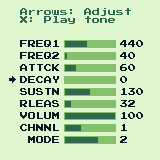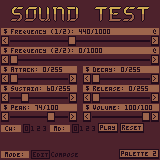Playing Audio
WASM-4's sound system has 4 independent channels. Each channel is dedicated to a different type of audio waveform.
- 2 pulse wave (square wave) channels. The classic chiptune sound.
- 1 triangle wave channel. A softer sound, great for bass.
- 1 noise channel. A harsh sound, for percussion and effects.
info
WASM-4's sound system is closely inspired by the architecture of the Nintendo NES and Gameboy.
Playing a Tone#
The tone() function is used to play a tone with a given frequency on a given channel.
tone (frequency, duration, volume, flags)
- Frequency is the "pitch", measured in hertz.
- Durations are measured in frames, 1/60ths of a second.
- Volume ranges from 0 (silent) to 100 (full volume).
- Flags sets the channel (0-3), duty cycle (0-3) and panning (0-2).
For example, to play a one second (60 frames) tone of 262 Hz (middle C) on the first pulse wave channel:
w4.tone(262, 60, 100, w4.TONE_PULSE1);tone(262, 60, 100, TONE_PULSE1);w4::tone(262, 60, 100, w4::TONE_PULSE1);w4.tone(262, 60, 100, w4.tonePulse1);w4.Tone(262, 60, 100, w4.TONE_PULSE1)tone(262, 60, 100, TONE_PULSE1)tone(262, 60, 100, TONE_PULSE1)w4.tone(262, 60, 100, .Pulse1)tone(262, 60, 100, TONE_PULSE1);import proc tone int int int int in end
$TONE_PULSE1 60 60 262 tonetone(262, 60, 100, TONE_PULSE1);tone(262, 60, 100, TONE_PULSE1);(import "env" "tone" (func $tone (param i32 i32 i32 i32)))
(call $tone (i32.const 262) (i32.const 60) (i32.const 100) (global.get $TONE_PULSE1))w4.tone(262, 60, 100, w4.TONE_PULSE1);Duty Cycle#
The duty cycle of the pulse channels can be controlled with additional flags:
| Flag | Duty Cycle |
|---|---|
TONE_MODE1 | 12.5% (default) |
TONE_MODE2 | 25% |
TONE_MODE3 | 50% |
TONE_MODE4 | 75% |
For example, to play at 50% duty cycle (square wave):
w4.tone(262, 60, 100, w4.TONE_PULSE1 | w4.TONE_MODE3);tone(262, 60, 100, TONE_PULSE1 | TONE_MODE3);w4::tone(262, 60, 100, w4::TONE_PULSE1 | w4::TONE_MODE3);w4.tone(262, 60, 100, w4.tonePulse1 | w4.toneMode3);w4.Tone(262, 60, 100, w4.TONE_PULSE1 | w4.TONE_MODE3)tone(262, 60, 100, TONE_PULSE1 | TONE_MODE3)tone(262, 60, 100, TONE_PULSE1 or TONE_MODE3)w4.tone(262, 60, 100, .Pulse1, .Half)tone(262, 60, 100, TONE_PULSE1 | TONE_MODE3);$TONE_PULSE1 $TONE_MODE3 or 100 60 262 tonetone(262, 60, 100, TONE_PULSE1 | TONE_MODE3);tone(262, 60, 100, TONE_PULSE1 | TONE_MODE3);(call $tone (i32.const 262) (i32.const 60) (i32.const 100) (i32.or (global.get $TONE_PULSE1) (global.get $TONE_MODE3)))w4.tone(262, 60, 100, w4.TONE_PULSE1 | w4.TONE_MODE3);Frequency Slide#
We can actually pass two different frequencies to tone(). The high 16 bits of the frequency
parameter is used for a second frequency. If non-zero, it specifies the frequency to slide to over
the duration of the tone.
For example, to slide the tone starting from 262 Hz and up to 523 Hz:
w4.tone(262 | (523 << 16), 60, 100, w4.TONE_PULSE1);tone(262 | (523 << 16), 60, 100, TONE_PULSE1);w4::tone(262 | (523 << 16), 60, 100, w4::TONE_PULSE1);w4.tone(262 | (523 << 16), 60, 100, w4.tonePulse1);w4.Tone(262 | (523 << 16), 60, 100, w4.TONE_PULSE1)tone(262 | (523 << 16), 60, 100, TONE_PULSE1)tone(262 or (523 shl 16), 60, 100, TONE_PULSE1)w4.tone(262 | (523 << 16), 60, 100, .Pulse1)tone(262 | (523 << 16), 60, 100, TONE_PULSE1);$TONE_PULSE1 100 60 523 16 shl 262 or tonetone(262 | (523 << 16), 60, 100, TONE_PULSE1);tone(262 | (523 << 16), 60, 100, TONE_PULSE1);(call $tone (i32.or (i32.const 262) (i32.shl (i32.const 523) (i32.const 16))) (i32.const 60) (i32.const 100) (global.get $TONE_PULSE1))w4.tone(262 | (523 << 16), 60, 100, w4.TONE_PULSE1);Volume#
There are two volume levels that can be passed to the tone function:
| Volume | Shift | Description |
|---|---|---|
| Sustain | 0 | The main volume used for the sustain duration. |
| Peak | 8 | Optional, the peak volume reached by the attack duration. |
If the peak volume is not set (or is set to 0), it defaults to 100.
ADSR Envelope#
ADSR describes how the volume changes over time, and has 4 time components:
| Time | Shift | Description |
|---|---|---|
| Attack | 24 | The time it takes to initially ramp up from 0 volume to peak volume. |
| Decay | 16 | The time taken to ramp down from peak volume to the sustain volume. |
| Sustain | 0 | The time to hold the tone steady at the sustain volume. |
| Release | 8 | The time to ramp back down to 0 volume. |
These times are all measured in frames (1/60th of a second), and can be packed
into the duration parameter.
For example, to play a tone that sustains for one second and releases over half a second (30 frames):
w4.tone(262, 60 | (30 << 8), 100, w4.TONE_PULSE1);tone(262, 60 | (30 << 8), 100, TONE_PULSE1);w4::tone(262, 60 | (30 << 8), 100, w4::TONE_PULSE1);w4.tone(262, 60 | (30 << 8), 100, w4.tonePulse1);w4.Tone(262, 60 | (30 << 8), 100, w4.TONE_PULSE1)tone(262, 60 | (30 << 8), 100, TONE_PULSE1)w4.tone(262, 60 | (30 << 8), 100, .Pulse1)tone(262, 60 | (30 << 8), 100, TONE_PULSE1);$TONE_PULSE1 100 30 8 shl 60 or 262 tonetone(262, 60 | (30 << 8), 100, TONE_PULSE1);tone(262, 60 | (30 << 8), 100, TONE_PULSE1);(call $tone (i32.const 262) (i32.or (i32.const 60) (i32.shl (i32.const 30) (i32.const 8))) (i32.const 100) (global.get $TONE_PULSE1))w4.tone(262, 60 | (30 << 8), 100, w4.TONE_PULSE1);Panning#
Tones can be panned either center (default), far left (TONE_PAN_LEFT),
or far right (TONE_PAN_RIGHT), similar to on a gameboy.
w4.tone(262, 60, 100, w4.TONE_PULSE1 | w4.TONE_PAN_LEFT);tone(262, 60, 100, TONE_PULSE1 | TONE_PAN_LEFT);w4::tone(262, 60, 100, w4::TONE_PULSE1 | w4::TONE_PAN_LEFT);w4.tone(262, 60, 100, w4.tonePulse1 | w4.tonePanLeft);w4.Tone(262, 60, 100, w4.TONE_PULSE1 | w4.TONE_PAN_LEFT)tone(262, 60, 100, TONE_PULSE1 | TONE_PAN_LEFT)tone(262, 60, 100, TONE_PULSE1 or TONE_PAN_LEFT)w4.tone(262, 60, 100, .Pulse1, .Half, .Left)tone(262, 60, 100, TONE_PULSE1 | TONE_PAN_LEFT);$TONE_PAN_LEFT $TONE_PULSE1 or 100 60 262 tonetone(262, 60, 100, TONE_PULSE1 | TONE_PAN_LEFT);tone(262, 60, 100, TONE_PULSE1 | TONE_PAN_LEFT);(call $tone (i32.const 262) (i32.const 60) (i32.const 100) (i32.or (global.get $TONE_PULSE1) (global.get $TONE_PAN_LEFT)))w4.tone(262, 60, 100, w4.TONE_PULSE1 | w4.TONE_PAN_LEFT);Note Mode#
By enabling Note Mode with the TONE_NOTE_MODE flag, tone will use MIDI note numbers rather than frequencies.
This results in more accurate pitches when playing musical notes.
You can read more about how this works in the tone(...) documentation.
Here's the same example as before, now playing middle-C using the MIDI note number 60:
w4.tone(60, 60, 100, w4.TONE_PULSE1 | w4.TONE_NOTE_MODE);tone(60, 60, 100, TONE_PULSE1 | TONE_NOTE_MODE);w4::tone(60, 60, 100, w4::TONE_PULSE1 | w4::TONE_NOTE_MODE);w4.tone(60, 60, 100, w4.tonePulse1 | w4.toneNoteMode);w4.Tone(60, 60, 100, w4.TONE_PULSE1 | w4.TONE_NOTE_MODE)tone(60, 60, 100, TONE_PULSE1 | TONE_NOTE_MODE)tone(60, 60, 100, TONE_PULSE1 or TONE_NOTE_MODE)w4.tone(60, 60, 100, .Pulse1, .Half, .Left, .Note)tone(60, 60, 100, TONE_PULSE1 | TONE_NOTE_MODE);$TONE_NOTE_MODE $TONE_PULSE1 or 100 60 60 tonetone(60, 60, 100, TONE_PULSE1 | TONE_NOTE_MODE);tone(60, 60, 100, TONE_PULSE1 | TONE_NOTE_MODE);(call $tone (i32.const 60) (i32.const 60) (i32.const 100) (i32.or (global.get $TONE_PULSE1) (global.get $TONE_NOTE_MODE)))w4.tone(60, 60, 100, w4.TONE_PULSE1 | w4.TONE_NOTE_MODE);Calculating Flags#
Setting ADSR flags require the use of various bitwise and bitshift operations. This can be a little confusing to understand.
These functions can be used to understand how they are calculated:
function toneFrequency(freq1: i32 = 0, freq2: i32 = 0): u32 { return freq1 | (freq2 << 16);}
function toneDuration(attack: i32 = 0, decay: i32 = 0, sustain: i32 = 0, release: i32 = 0): u32 { return (attack << 24) | (decay << 16) | sustain | (release << 8);}
function toneVolume(peak: i32 = 0, volume: i32 = 0): u32 { return (peak << 8) | volume;}
function toneFlags(channel: i32 = 0, mode: i32 = 0, pan: i32 = 0): u32 { return channel | (mode << 2) | (pan << 4);}fn uint tone_frequency(uint freq1, uint freq2){ return freq1 | (freq2 << 16)}
fn uint tone_duration(uint attack, uint decay, uint sustain, uint release){ return (attack << 24) | (decay << 16) | sustain | (release << 8)}
fn uint tone_volume(uint peak, uint volume){ return: (peak << 8) | volume}
fn uint tone_flags(uint channel, uint mode, uint pan){ return: channel | (mode << 2) | (pan << 4)}fn tone_frequency(freq1: u32, freq2: u32) -> u32{ return: freq1 | (freq2 << 16)}
fn tone_duration(attack: u32, decay: u32, sustain: u32, release: u32) -> u32{ return: (attack << 24) | (decay << 16) | sustain | (release << 8)}
fn tone_volume(peak: u32, volume: u32) -> u32{ return: (peak << 8) | volume}
fn tone_flags(channel: u32, mode: u32, pan: u32) -> u32{ return: channel | (mode << 2) | (pan << 4)}fn tone_frequency(freq1: u32, freq2: u32) -> u32 { freq1 | (freq2 << 16)}
fn tone_duration(attack: u32, decay: u32, sustain: u32, release: u32) -> u32 { (attack << 24) | (decay << 16) | sustain | (release << 8)}
fn tone_volume(peak: u32, volume: u32) -> u32 { (peak << 8) | volume}
fn tone_flags(channel: u32, mode: u32, pan: u32) -> u32 { channel | (mode << 2) | (pan << 4)}Sound Tool#
The sound demo, sound test and IWAS are a great way to quickly experiment with different sounds and find values to plug into your game:


